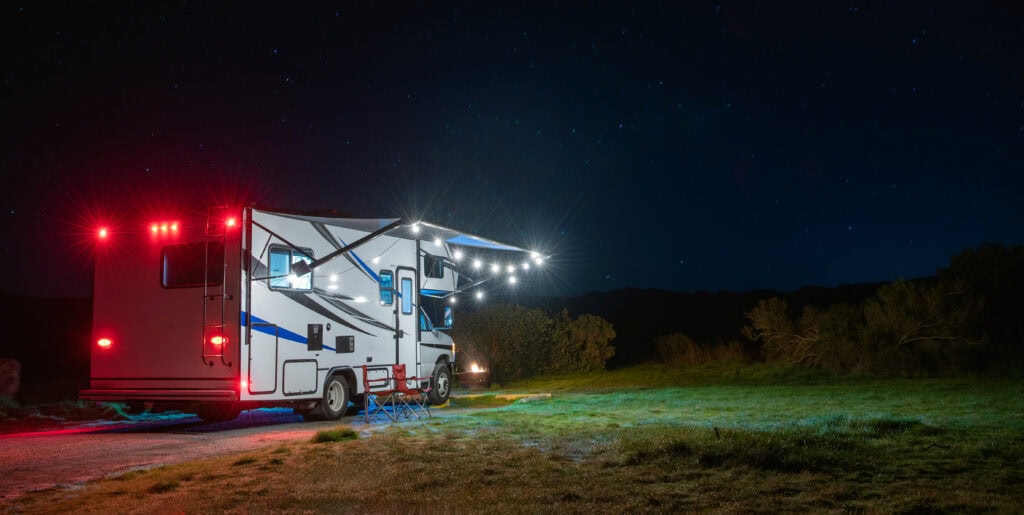Rolling into a new RV park means one thing has to work flawlessly: your power hookup. Whether you’re just here for the weekend or planning a longer stay, understanding shore power and how to protect your rig from electrical mishaps is essential. At Coastal Cowboy RV Park, we offer both 30-amp and 50-amp power services so you can hook up with confidence. Let’s break down the basics and make sure your RV stays powered, protected, and problem-free.
What is shore power?
Shore power is the electricity provided by a power pedestal at your campsite. Instead of relying on your generator or battery bank, shore power lets you plug directly into the grid using a heavy-duty cord. This powers your A/C, lights, fridge, outlets, and more without draining your internal systems.
When you hook up to shore power, you’re relying on the infrastructure of the park. That’s why it’s important to understand how much power you’re drawing, and whether you’re connected properly. Knowing how to use it safely keeps your setup running smoothly and extends the life of your RV’s electrical system.
30-amp vs 50-amp: what’s the difference?
The numbers refer to how much electrical current the hookup provides. A 30-amp connection gives you access to 3,600 watts of power, which is perfect for smaller RVs with fewer high-draw appliances. A 50-amp service, on the other hand, delivers a whopping 12,000 watts and is designed for bigger rigs that need more juice.
If your RV is wired for 30 amps and you plug into a 50-amp pedestal using an adapter, your rig will still only draw up to 30 amps. The same is true in reverse: plugging a 50-amp rig into a 30-amp hookup will work, but you’ll need to manage your power use carefully to avoid tripping breakers or overloading circuits.
Why RV Size and Appliance Load Matter
Your RV’s size often determines the kind of power it requires. Travel trailers and smaller Class C models generally use 30-amp service. Larger fifth wheels and Class A motorhomes typically come equipped with 50-amp connections to support multiple A/C units, electric water heaters, and high-end appliances.
Trying to power too much on a 30-amp system can lead to annoying breaker trips, or worse, damaged electronics. If you’re running the A/C, microwave, coffee maker, and water heater simultaneously on a 30-amp connection, you’re flirting with overload. Know your setup and manage your appliances wisely.
Shore Power Safety Tips Every RVer Should Know
Before plugging in, always inspect the power pedestal. Look for signs of damage, rust, or loose connections. If something looks off, let the park staff know. Always turn off the breaker before plugging in your cord to avoid sparking.
Once you’re plugged in, switch the breaker on and check for stable power. Using a voltmeter or surge protector with a display helps confirm everything is running smoothly. It’s a quick step that can prevent major problems down the road.
Why You Need a Surge Protector
A surge protector is your first and best line of defense. It sits between your RV and the power source, monitoring for voltage spikes, drops, or wiring issues. If something goes wrong, like a sudden surge from a lightning strike or a faulty pedestal, the surge protector shuts down the connection before damage is done.
There are two types: basic surge protectors, which block voltage spikes, and full Electrical Management Systems (EMS), which also monitor for open grounds, reverse polarity, and high or low voltage. For peace of mind, an EMS is worth the extra cost, especially for full-time travelers or those with high-end electronics onboard.
Can I Use Adapters Between 30-Amp and 50-Amp?
Yes, you can, but with limitations. If you have a 30-amp RV and plug into a 50-amp pedestal with a dogbone adapter, your RV will still only draw 30 amps. That adapter doesn’t increase your capacity; it just allows you to make the connection.
If you’re plugging a 50-amp rig into a 30-amp pedestal, it works, but you must be careful. You’ll only get a fraction of your normal power, so plan ahead. Turn off one A/C unit, limit use of the microwave, and unplug the space heater. Staying under the threshold will keep your breakers from popping.
Protect Your Investment from the Start
Electrical issues can lead to some of the most expensive RV repairs. Power surges can fry air conditioners, ruin circuit boards, and destroy sensitive electronics. Investing in surge protection and understanding your amperage needs is more than a safety move; it’s a smart financial decision.
Even if the park has modern pedestals and reliable infrastructure like we do at Coastal Cowboy RV Park, surge protection is your responsibility. It’s a one-time purchase that protects your rig every time you plug in. Don’t skip it.
Coastal Cowboy RV Park: Power Up and Relax
At Coastal Cowboy RV Park, we provide both 30-amp and 50-amp hookups on well-maintained pedestals, so every guest, no matter their RV size, can plug in with ease. Our goal is to offer a safe, stress-free stay where you never have to second-guess your setup. Whether you’re here for the weekend or settling in for a long-term visit, we’ve got the power you need.
And if you ever have questions about shore power, adapters, or safety, we’re here to help. Our team is happy to assist with setup and make sure your RV experience is smooth from the moment you arrive.
Contact Us Today!
Experience the comfort, community, and coastal charm of the Texas Gulf Coast. Whether you choose Coastal Cowboy RV Park, Redfish Bay RV Park, or Sunrise RV Resort, you’ll find the perfect place to relax, recharge, and feel at home from the moment you arrive.
